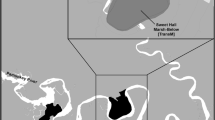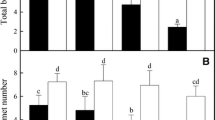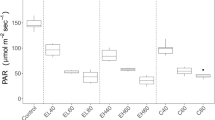Abstract
Brown seaweeds can serve as habitat and food for a number of mesoherbivore species, but the effect of mesoherbivore grazing on the fitness of individual seaweed plants is not well documented. Here we investigate how mechanical wounding, which mimics the grazing damage made by the herbivorous gastropod Littorina obtusata, affects the biomass change, apical growth, and individual shoot strength of the fucoid seaweed species Ascophyllum nodosum both in natural field populations and in the laboratory. We did not detect a significant effect of wounding on apical shoot growth in the laboratory, but wounding decreased the plant biomass in half of the studied A. nodosum populations in the field. Furthermore, we found that the strength of individual A. nodosum shoots was significantly lower when compared with unwounded control shoots initially after wounding. However, after 11 days incubation in the laboratory, the strength of the wounded shoots had increased almost to the level of the control shoots, although there was still a significant difference in the force required to break the shoots. These results indicate that wounding can increase the tissue loss (and thereby decrease the fitness) of A. nodosum plants in natural populations, probably through weakening of individual shoots. However, A. nodosum appears to have a mechanism to strengthen the shoots after mechanical wounding, and therefore, the timing of damage (e.g. prior to a storm) probably determines the amount of plant tissue lost through wave-induced forces.




Similar content being viewed by others
References
Amsler CD (2001) Induced defenses in macroalgae: the herbivore makes a difference. J Phycol 37:353–356
Arrontes J (1999) On the evolution of interactions between marine mesoherbivores and algae. Bot Mar 42:137–155
Borell EM, Foggo A, Coleman RA (2004) Induced resistance in intertidal macroalgae modifies feeding behaviour of herbivorous snails. Oecologia 140:328–334
Brawley SH, Fei XG (1987) Studies of mesoherbivory in aquaria and in an unbarricated mariculture farm on the Chinese coast. J Phycol 23:614–623
Cronin G, Hay ME (1996) Induction of seaweed chemical defenses by amphipod grazing. Ecology 77:2287–2301
DeWreede RE, Ewanchuk P, Shaughnessy F (1992) Wounding, healing, and survivorship in 3 kelp species. Mar Ecol Prog Ser 82:259–266
Duffy JE, Hay ME (1990) Seaweed adaptations to herbivory. BioScience 40:368–375
Duffy JE, Hay ME (2000) Strong impacts of grazing amphipods on the organization of a benthic community. Ecol Monogr 70:237–263
Duggins D, Eckman JE, Siddon CE, Klinger T (2001) Interactive roles of mesograzers and current flow in survival of kelps. Mar Ecol Prog Ser 223:143–155
Fagerberg WR, Dawes CJ (1976) Studies on Sargassum. I. A light microscopic examination of the wound regeneration process in mature stipes of S. filipendula. Am J Bot 63:110–119
Fagerberg WR, Dawes CJ (1977) Studies on Sargassum. II. Quantitative ultrastructural changes in differentiated stipe cells during wound regeneration and regrowth. Protoplasma 92:211–227
Fulcher RG, McCully ME (1969) Histological studies on the genus Fucus. IV. Regeneration and adventive embryony. Can J Bot 47:1643–1649
Fulcher RG, McCully ME (1971) Histological studies on the genus Fucus. V. An autoradiographic and electron microscopic study of the early stages of regeneration. Can J Bot 49:161–165
Haring RN, Dethier MN, Williams SL (2002) Desiccation facilitates wave-induced mortality of the intertidal alga Fucus gardneri. Mar Ecol Prog Ser 232:75–82
Hay ME, Steinberg PD (1992) The chemical ecology of plant-herbivore interactions in marine versus terrestrial communities. In: Rosenthal GA, Berenbaum MR (eds) Herbivores: their interaction with secondary plant metabolites. Academic, New York, pp 371–413
Lowell RB, Markham JH, Mann K (1991) Herbivore-like damage induces increased strength and toughness in a seaweed. Proc R Soc Lond Ser B: Biol Sci 243:31–38
Lüder UH, Clayton MN (2004) Induction of phlorotannins in the brown macroalga Ecklonia radiata (Laminariales, Phaeophyta) in response to simulated herbivory—a first microscopic study. Planta 218:928–937
Markel RW, DeWreede RE (1998) Mechanisms underlying the effect of the chiton Katharina tunicata on the kelp Hedophyllum sessile: size escapes and indirect effects. Mar Ecol Prog Ser 166:151–161
Padilla DK (1993) Rip stop in marine algae- minimizing the consequences of herbivore damage. Evol Ecol 7:634–644
Pavia H, Brock E (2000) Extrinsic factors influencing phlorotannin production in the brown seaweed Ascophyllum nodosum. Mar Ecol Prog Ser 193:285–294
Pavia H, Toth GB (2000) Inducible chemical resistance to herbivory in the brown seaweed Ascophyllum nodosum. Ecology 81:3212–3225
Pavia H, Carr H, Åberg P (1999) Habitat and feeding preferences of crustacean mesoherbivores inhabiting the brown seaweed Ascophyllum nodosum (L.) Le Jol. and its epiphytic macroalgae. J Exp Mar Biol Ecol 236:15–32
Pavia H, Toth GB, Åberg P (2002) Optimal defence theory: elasticity analysis as a tool to predict intraplant variation in defences. Ecology 83:891–897
Rohde S, Molis M, Wahl M (2004) Regulation of anti-herbivore defence by Fucus vesiculosus in response to various cues. J Ecol 92:1011–1018
Sotka E, Taylor RB, Hay ME (2002) Tissue specific induction of resistance to herbivores in a brown seaweed: the importance of direct grazing versus waterborne signals from grazed neighbors. J Exp Mar Biol Ecol 277:1–12
Steneck RS, Watling L (1982) Feeding capabilities and limitations of herbivorous molluscs: a functional group approach. Mar Biol 68:299–319
Taylor RB, Sotka E, Hay ME (2002) Tissue-specific induction of herbivore resistance: seaweed response to amphipod grazing. Oecologia 132:68–76
Tegner MJ, Dayton PK, Edwards PB, Riser KL (1995) Sea urchin cavitation of giant kelp (Macrocystis pyrifera C. Agardh) holdfasts and its effects on kelp mortality across a large California forest. J Exp Mar Biol Ecol 191:83–99
Toth GB, Pavia H (2000) Water-borne cues induce chemical defense in a marine algae (Ascophyllum nodosum). Proc Natl Acad Sci USA 97:14418–14420
Underwood AJ (1997) Experiments in ecology: their logical design and interpretation using analysis of variance. Cambridge University Press, Cambridge
Vermeij GT (1992) Time of origin and biogeographical history of specialized relationships between northern marine plants and herbivorous molluscs. Evolution 46:657–664
Viejo RM, Åberg P (2001) Effects of density on the vital rates of a modular seaweed. Mar Ecol Prog Ser 221:105–115
Watson DC, Norton TA (1987) The habitat and feeding preferences of Littorina obtusata (L.) and L. marie Sacchi et Rastelli. J Exp Mar Biol Ecol 112:61–72
Weidner K, Lages BG, da Gama BAP, Molis M, Wahl M, Pereira RC (2004) Effect of mesograzers and nutrient levels on induction of defenses in several Brazilian macroalgae. Mar Ecol Prog Ser 283:113–125
Acknowledgements
We are grateful to C. Appelqvist, M. Hemmingsson, H. Johansson, O. Langhamer, and J. Lycken for practical assistance and fruitful discussions. The experiments performed in the present study comply with current Swedish laws. This study was supported by the European Union through The European Regional Development Fund (ERDF) Objective 2 West Sweden and through the Swedish Research Council through contract no. 621-2003-2883 to GT and 21.0/2003-1122 to HP.
Author information
Authors and Affiliations
Corresponding author
Additional information
Communicated by M. Kühl, Helsingør
Rights and permissions
About this article
Cite this article
Toth, G.B., Pavia, H. Artificial wounding decreases plant biomass and shoot strength of the brown seaweed Ascophyllum nodosum (Fucales, Phaeophyceae). Marine Biology 148, 1193–1199 (2006). https://doi.org/10.1007/s00227-005-0167-2
Received:
Accepted:
Published:
Issue Date:
DOI: https://doi.org/10.1007/s00227-005-0167-2




